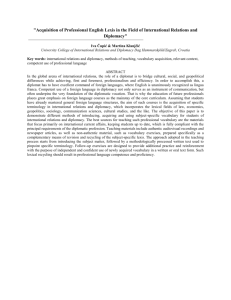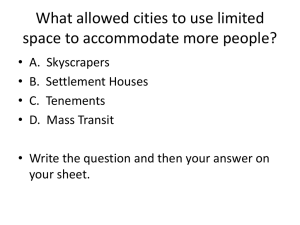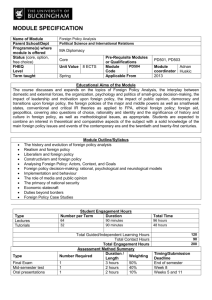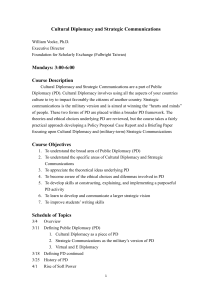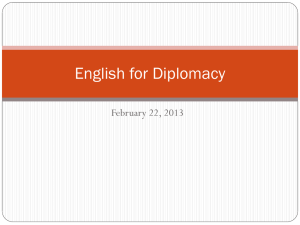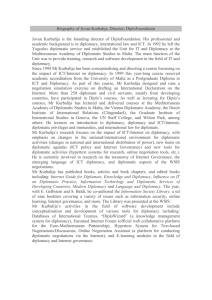Foreign Policy of EU Member States
advertisement
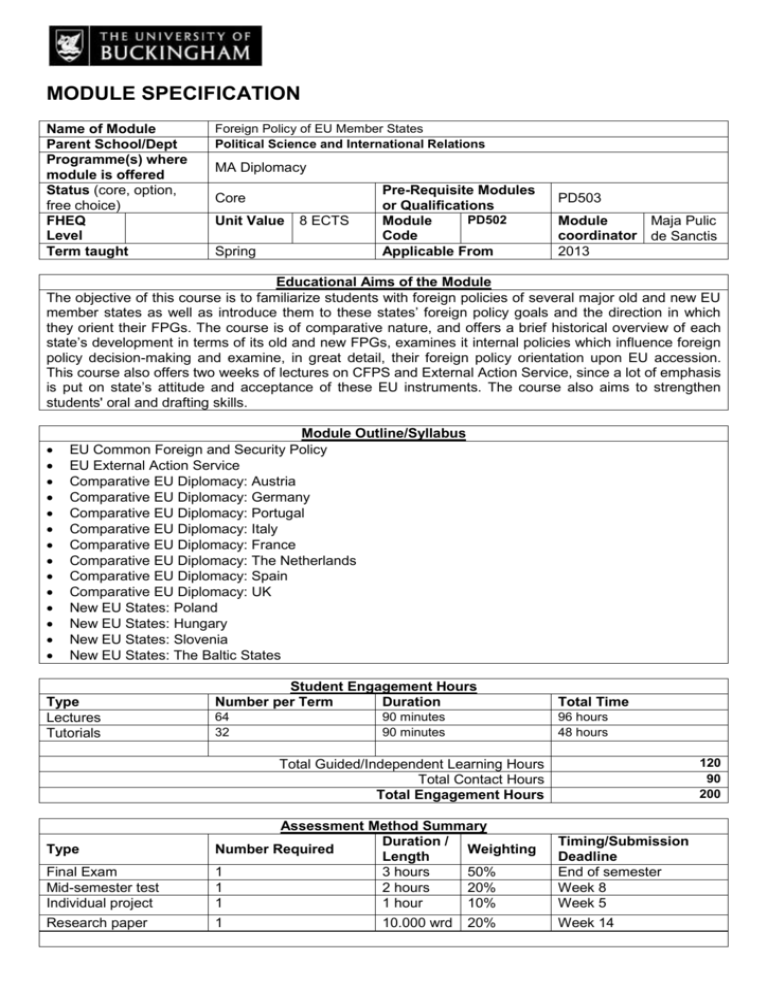
MODULE SPECIFICATION Name of Module Parent School/Dept Programme(s) where module is offered Status (core, option, free choice) FHEQ Level Term taught Foreign Policy of EU Member States Political Science and International Relations MA Diplomacy Core Unit Value Spring 8 ECTS Pre-Requisite Modules or Qualifications PD502 Module Code Applicable From PD503 Module Maja Pulic coordinator de Sanctis 2013 Educational Aims of the Module The objective of this course is to familiarize students with foreign policies of several major old and new EU member states as well as introduce them to these states’ foreign policy goals and the direction in which they orient their FPGs. The course is of comparative nature, and offers a brief historical overview of each state’s development in terms of its old and new FPGs, examines it internal policies which influence foreign policy decision-making and examine, in great detail, their foreign policy orientation upon EU accession. This course also offers two weeks of lectures on CFPS and External Action Service, since a lot of emphasis is put on state’s attitude and acceptance of these EU instruments. The course also aims to strengthen students' oral and drafting skills. Module Outline/Syllabus EU Common Foreign and Security Policy EU External Action Service Comparative EU Diplomacy: Austria Comparative EU Diplomacy: Germany Comparative EU Diplomacy: Portugal Comparative EU Diplomacy: Italy Comparative EU Diplomacy: France Comparative EU Diplomacy: The Netherlands Comparative EU Diplomacy: Spain Comparative EU Diplomacy: UK New EU States: Poland New EU States: Hungary New EU States: Slovenia New EU States: The Baltic States Type Lectures Tutorials Student Engagement Hours Number per Term Duration Total Time 64 32 96 hours 48 hours 90 minutes 90 minutes 120 90 200 Total Guided/Independent Learning Hours Total Contact Hours Total Engagement Hours Final Exam Mid-semester test Individual project Assessment Method Summary Duration / Number Required Weighting Length 1 3 hours 50% 1 2 hours 20% 1 1 hour 10% Timing/Submission Deadline End of semester Week 8 Week 5 Research paper 1 Week 14 Type 10.000 wrd 20% Intended Learning Outcomes: Module Outcomes Teaching and Learning Strategy: At the end of the Course, students should be able to: 1. Show comprehensive understanding of the political and historical factors that influenced the development of European diplomacy as we see it today; 2. Demonstrate understanding of on individual states’ foreign policies and be able to analyse the reasons for particular state’s behaviour in terms of its FPGs. 3. Demonstrate acquaintance of different segments of EU member states' foreign policy and the forces that drive it, as well as most pressing issues of foreign policy on the EU scene; 1. Demonstrate understanding of the practical level of the way foreign policy is carried out in individual EU member states and the roles of individuals and institutions that perform diplomatic functions. Practical Skills 1. Ability to analyze foreign policy moves of EU MSs; 2. Ability to interpret EU diplomatic texts and agreements; 3. Public speaking. 1. Course readings and class discussions. (ILO: 1-4); → 2. In-class exercises, simulation games, student presentations (ILO: 1-4); 3. Lectures/presentations, case-studies, (ILO: 1-4). Assessment Strategy 1. Course work –mid-term exam (20%), research paper (20%) and in-class presentations (10%). (ILO:1-4); → 2. Final Exam – 50% (ILO: 1-4). Teaching and Learning Strategy: → 1. Individual project assignment (PS: 1-3) 2. In-class speaking and debate exercises (PS: 2-3) 3. Instructor supported practicals (PS: 1-3) Assessment Strategy → 1. Written Exam (PS: 1-2) 2. Individual Project (PS: 1-3) 3. Research paper (PS: 1-2) Transferable Skills Teaching and Learning Strategy: 1. Understand and interpret EU foreign policy texts using basic terms. 2. Interpret in basic terminology different foreign policies and understand decisionmaking procedures in the European Union. 3. Carry out public speaking, with a clarity of oral argument and presentation 4. Engage in clear and effective written arguments and presentations. 5. Engage successfully in discussion with different viewpoints. 1. Course readings and class discussions. (TS: 1, 2, 3, 5) 2. Lectures and in-class exercises s (TS: 1, 2, 3, 5) 3. In-class presentations, public speaking exercises and simulation games. (TS: 1, 2, 4, 5) 4. Research papers, exercises on diplomatic correspondence, student presentations. (TS: 1, 2, 3, 5) 5. Model exercises. (TS: 1- 5) → Assessment Strategy → 1. Course work –mid-term exam (20%), research paper (20%) and in-class presentations (10%). (TS:1-5); 2. 3. Final Exam – 50% (TS: 1-5). Key Texts and/or other learning materials Hocking, B., Spence, D. (2003). Foreign Ministries in the European Union: Integrating Diplomats. Palgrave Macmillan. Cardwell, J. (2009). EU External Relations and Systems of Governance: The CFSP, Euro-Mediterranean Partnership and Migration. Routledge. Hadfield, A. et al. (2013). Foreign Policies of EU Member States. Routledge. (from April 2013). Baun, M., Marek, D. (2012).The New Member States and the European Union: Foreign Policy and Europeanization. Routledge. Journal Articles: Berthélemy, J.C., Maurel, M. (2009). The consistency of EU foreign policies towards new member states. Economic Papers 365, European Commission. Cellerino, C. (2011). The New European External Action Service and the Lisbon Call for Coherence of European External Action: Issues of Accountability and Scope. The Columbia Journal of European Law. Král, D. (2005). Enlarging Eu Foreign Policy – The Role of New EU member States and Candidate Countries. EUROPEUM Institute for European Policy. Government publications: House of Commons Library. British Foreign Policy Since 1997. (2008). Research paper 08/05, 23 June 2008. Several videos produced by the TV Newsroom of the European Council examining the role of EU EAS are played in class, depending on the case-studies covered and student interest. Please note: This specification provides a concise summary of the main features of the module and the learning outcomes that a typical student might reasonably be expected to achieve and demonstrate if he/she takes full advantage of the learning opportunities that are provided. More detailed information on the learning outcomes, content and teaching, learning and assessment methods of each module and programme can be found in the departmental or programme handbook. The accuracy of the information contained in this document is reviewed annually by the University of Buckingham and may be checked by the Quality Assurance Agency. Date of Production 28 August 2013 Date approved by School Learning and Teaching Committee Date approved by School Board of Study Date approved by University Learning and Teaching Committee Date of Annual Review
